"There is in this particular region a collection of races
diverse in feature, language and customs such as cannot,
perhaps, be paralleled in any other part of the world".
[Gazetteer of Upper Burma and the Shan States, Sir George Scott, 1899]
diverse in feature, language and customs such as cannot,
perhaps, be paralleled in any other part of the world".
[Gazetteer of Upper Burma and the Shan States, Sir George Scott, 1899]
"We shall never be able to trace all the people who
now inhabit Burma back fully to their original seats,
or say precisely where they had their beginnings".
['The Tribes of Burma', C.C. Lowis, 1919]
now inhabit Burma back fully to their original seats,
or say precisely where they had their beginnings".
['The Tribes of Burma', C.C. Lowis, 1919]
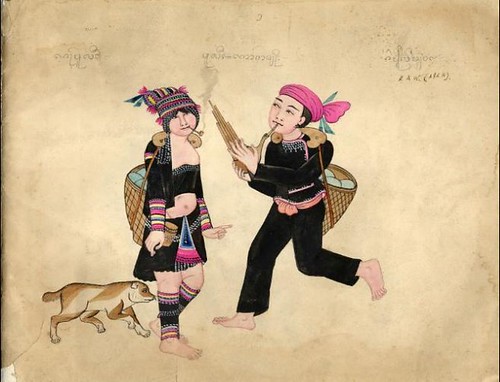
Kaw (Ahkra)
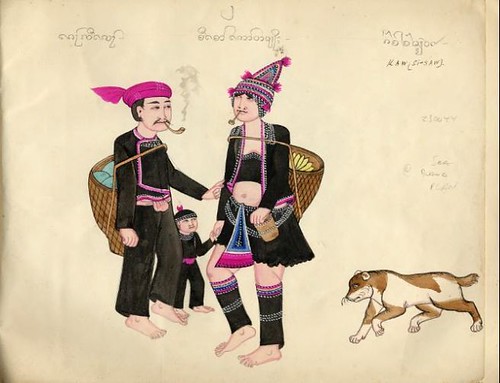
Kaw (Si-Saw)
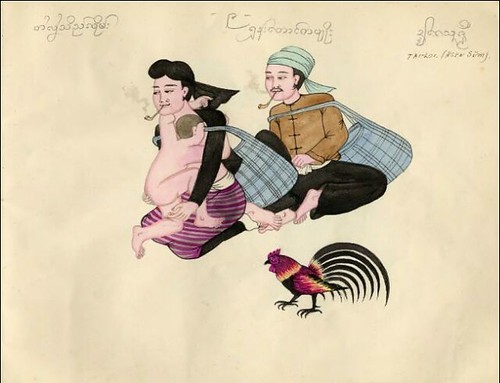
Tai-Loi (Hsen Suni)

Lihsaw
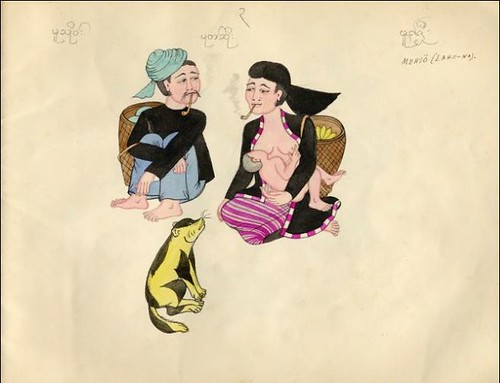
Muhso (Lahu-Na)
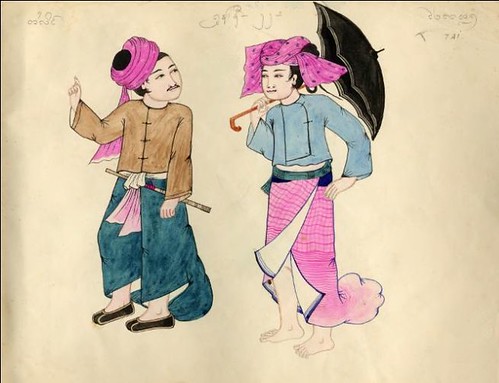
Tai
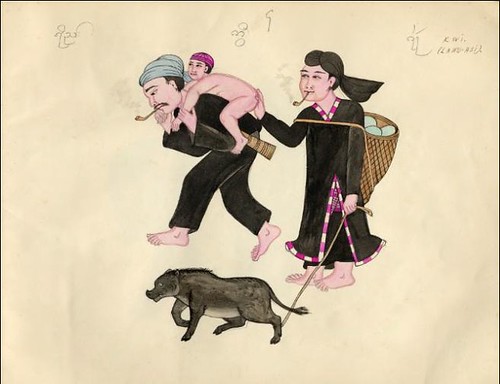
Kwi (Lahu-Hsi)
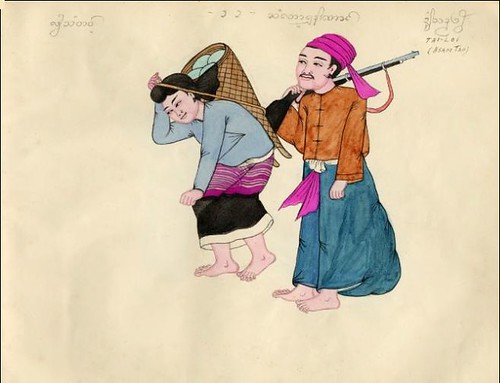
Tai-loi (Hsam Tao)
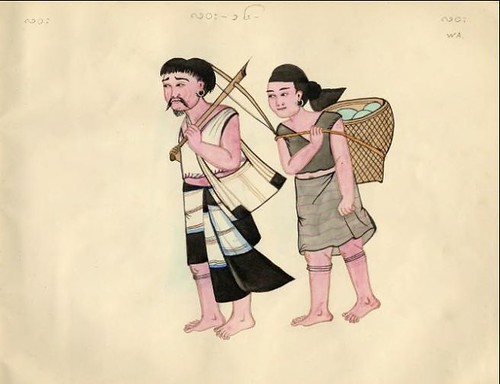
Wa
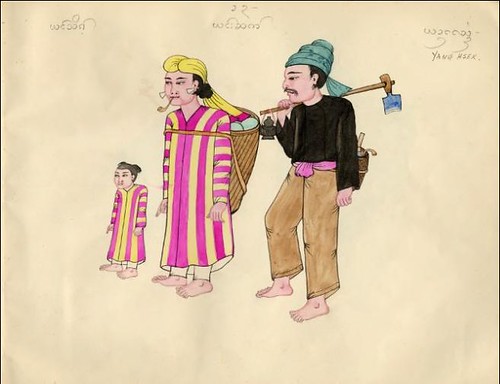
Yang Hsek
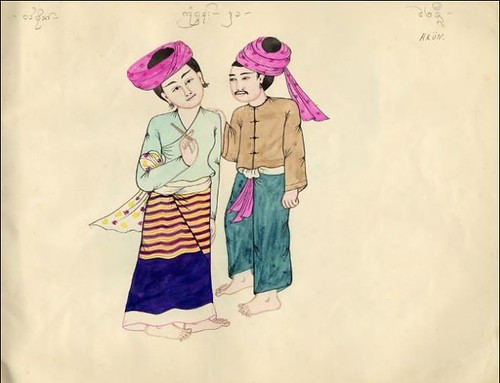
Hkun
We are told:
"A Hand Painted Manuscript, in Color, of the Kaw, Lahu, Kwi, En, Ahko, Hpin, Tai-Loi, Yang Hsek, Palawng, Kachin, Wa Lu, Lem, Tai-no, Lisaw, Hkun and Tai tribes. Hand drawn, hand colored ethnographic manuscript showing people from various ethnic groups in Burma at their daily chores and in their native costume, ca. 1900."The 'Tribes of Burma' manuscript comes from the South East Asia Digital Library at the Northern Illinois University Libraries, Special Collections. [homepage] All the above images were modestly background cleaned and are screencaps taken from djvu files at 100%.
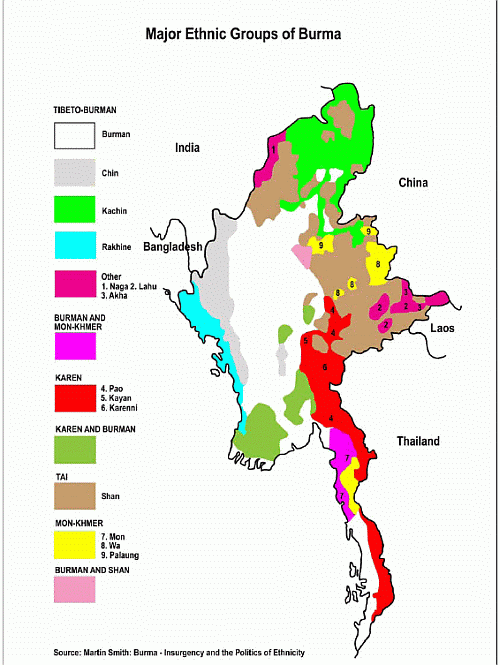
'Chronic Emergency - Health and
Human Rights in Eastern Burma'
{Executive Summary} Published in 2006
Back Pack Health Worker Team - An agency from Thailand [Source]
Human Rights in Eastern Burma'
{Executive Summary} Published in 2006
Back Pack Health Worker Team - An agency from Thailand [Source]
"Disinvestment in health, coupled with widespread poverty,
corruption, and the dearth of skilled personnel have resulted in the
collapse of Burma’s health system. Today, Burma’s health indicators
by official figures are among the worst in the region. However,
information collected by the Back Pack Health Workers Team
(BPHWT) on the eastern frontiers of the country, facing decades of
civil war and widespread human rights abuses, indicate a far greater
public health catastrophe in areas where official figures are not
collected.
In these eastern areas of Burma, standard public health
indicators such as population pyramids, infant mortality rates, child
mortality rates, and maternal mortality ratios more closely resemble
other countries facing widespread humanitarian disasters, such as
Sierra Leone, the Democratic Republic of the Congo, Niger, Angola,
and Cambodia shortly after the ouster of the Khmer Rouge.
The most common cause of death continues to be malaria, with over
12% of the population at any given time infected with Plasmodium
falciparum, the most dangerous form of malaria. One out of every
twelve women in this area may lose her life around the time of
childbirth, deaths that are largely preventable. Malnutrition is
unacceptably common, with over 15% of children at any time with
evidence of at least mild malnutrition, rates far higher than their
counterparts who have fled to refugee camps in Thailand. Knowledge
of sanitation and safe drinking water use remains low.
Human rights violations are very common in this population.
Within the year prior, almost a third of households had suffered from
forced labor, almost 10% forced displacement, and a quarter had
had their food confiscated or destroyed. Approximately one out of
every fifty households had suffered violence at the hands of soldiers,
and one out of 140 households had a member injured by a landmine
within the prior year alone. There also appear to be some regional
variations in the patterns of human rights abuses. Internally displaced
persons (IDPs) living in areas most solidly controlled by the SPDC and its allies, such as Karenni State and Pa’an District, faced more
forced labor while those living in more contested areas, such as
Nyaunglebin and Toungoo Districts, faced more forced relocation.
Most other areas fall in between these two extremes. However,
such patterns should be interpreted with caution, given that the BPHW
survey was not designed to or powered to reliably detect these
differences.
Using epidemiologic tools, several human rights abuses were
found to be closely tied to adverse health outcomes. Families forced
to flee within the preceding twelve months were 2.4 times more likely
to have a child (under age 5) die than those who had not been forcibly
displaced. Households forced to flee also were 3.1 times as likely
to have malnourished children compared to those in more stable
situations.
Food destruction and theft were also very closely tied to several
adverse health consequences. Families which had suffered this
abuse in the preceding twelve months were almost 50% more likely
to suffer a death in the household. These households also were 4.6
times as likely to have a member suffer from a landmine injury, and
1.7 times as likely to have an adult member suffer from malaria,
both likely tied to the need to forage in the jungle. Children of these
households were 4.4 times as likely to suffer from malnutrition
compared to households whose food supply had not been
compromised.
For the most common abuse, forced labor, families that had
suffered from this within the past year were 60% more likely to have
a member suffer from diarrhea (within the two weeks prior to the
survey), and more than twice as likely to have a member suffer from
night blindness (a measure of vitamin A deficiency and thus
malnutrition) compared to families free from this abuse.
Not only are many abuses linked statistically from field
observations to adverse health consequences, they are yet another
obstacle to accessing health care services already out of reach for
the majority of IDP populations in the eastern conflict zones of Burma.
This is especially clear with women’s reproductive health: forced
displacement within the past year was associated with a 6.1 fold
lower use of contraception. Given the high fertility rate of this
population and the high prevalence of conditions such as malaria
and malnutrition, the lack of access often is fatal, as reflected by
the high maternal mortality ratio—as many as one in 12 women will
die from pregnancy-related complications."
- Online Burma/Myanmar Library - Ethnic Groups in Burma (cultural, political). [homepage]
- The CIA World Factbook.
- Human Rights Watch.
- Burma Project/Southeast Asia Initiative (Soros Foundation).
- Daw Aung San Suu Kyi pages.
- Previously.
- 'The Vanishing Tribes of Burma' by Richard K Diran 1999. [article]



























































7 comments :
Hi,
Not related to this post but I read this article regarding scanning of old books and I thought it might interest you, in case you did not see it yet:
http://spectrum.ieee.org/jan08/5835
There's even a video of the thingy:
http://www.youtube.com/watch?v=oMfgbbFudgY
Great blog, btw
Thanks David, great link. I do very much enjoy learning about the technical sides. Same goes for book preservation/restoration - another topic I keep lightly in the back of my mind but hardly ever find good and accessible links about.
(will check out the youtube later too).
these pictures are so beautiful and colorful. perfect for a gray new england day.
Merci pour vos trés belles images et explications.
I was going to inquire whether your sources provided any illumination on the prevalence of pipe-smoking among the various ethnic groups (why some are shown with both adults smoking, some with only one, and some with none), but the health/human rights report is too depressing for me to indulge in historical trivialities.
PK, wow. I've thought frequently about this post over the past few weeks. I think it's a good application of beauty to social justice. I have several Burmese minority friends (Karen, Jingpho, Zaiwa, Rawang, etc)--brilliant souls--alive to life and better humans than I am, but they and their families and friends have endured enormous humiliation and instability.
Your post reminds me of a book I want to read: /On Beauty and Being Just/ by Elaine Scarry. Endangered languages and cultures are also part of the human rights mix in SE Asia/SW China in general. Maybe simple beauty can call attention to such problems more effectively than moralizing dogma and political rhetoric.
Oh, on the pipe question from karla: I've done a lot of linguistic research on related ethnic minorities in China and pipe smoking varies. In most groups only men smoke; in others women have special pipes that they stick into their frontispieces (upper aprons) and pull out for a smoke when taking a break in the fields.
Thanks JP. I too had been thinking about the pipes. I decided that I thought that they could have been indiscriminately included for so many reasons that I couldn't quite decide which version sounded more plausible to me. Your is as good as any, and probably closer the Occam's Razor position in any event.
I was fortunate enough to encounter some related tribes (Tay and...I forget which others) in the far north of Vietnam. Gentle, happy folk.
It's perhaps a measure of the impotence and futility of an era or the will of the world when beauty can be regarded as an effective means of political commentary/criticism. Oy.
Post a Comment
Comments are all moderated so don't waste your time spamming: they will never show up.
If you include ANY links that aren't pertinent to the blog post or discussion they will be deleted and a rash will break out in your underwear.
Also: please play the ball and not the person.
Note: only a member of this blog may post a comment.